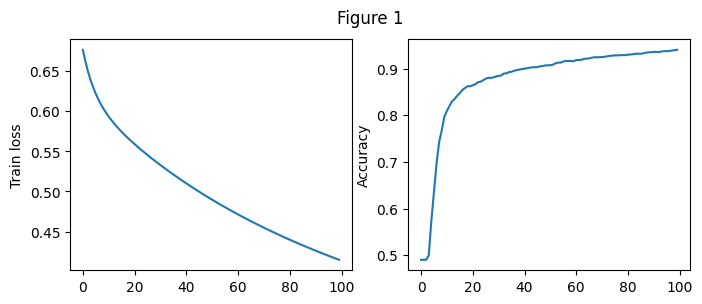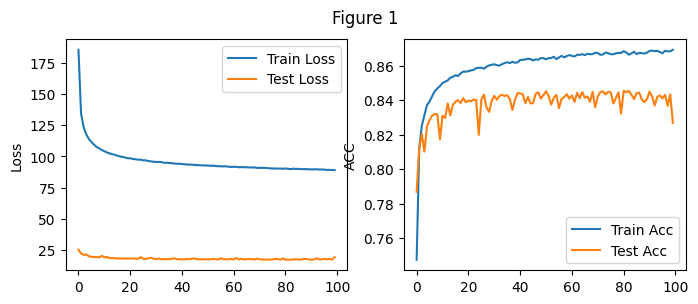Python 官方文档:入门教程 => 点击学习
其他文章 手动以及使用torch.nn实现logistic回归和softmax回(当前文章)手动以及使用torch.nn实现前馈神经网络实验 文章目录 任务一、Pytorch基本操作考察1.1
其他文章
1. 构造人工数据集2. 构造dataloader3. 根据函数实现logistics模型4. 从dataloader中读取数据并训练模型import torchm = torch.arange(4,7).view(1,3)n = torch.arange(1,3).view(2,1)print('M:', m, '\nN:', n )m_n = m - nprint('减法1:', m_n)print('减法2:', m.subtract(n))M: tensor([[4, 5, 6]]) N: tensor([[1], [2]])减法1: tensor([[3, 4, 5], [2, 3, 4]])减法2: tensor([[3, 4, 5], [2, 3, 4]])m.sub_(n)print(m)---------------------------------------------------------------------------RuntimeError Traceback (most recent call last)D:\System_Cache\ipykernel_536\2094312564.py in ----> 1 m.sub_(n) 2 print(m)RuntimeError: output with shape [1, 3] doesn't match the broadcast shape [2, 3] P = torch.nORMal(mean=0, std=0.01, size=[3,2])Q = torch.normal(mean=0, std=0.01, size=[4,2])Q_T = Q.t()print(torch.mm(P,Q_T))tensor([[ 8.2229e-06, 7.3925e-06, -1.2496e-05, 1.7892e-05], [ 6.1172e-05, 4.5944e-05, -3.5777e-05, 1.0136e-04], [-6.6844e-05, -4.2414e-05, -1.0137e-05, -8.3430e-05]])import torchx = torch.tensor(1, requires_grad = True, dtype=torch.float32)print(x)print(x.grad)y1 = x ** 2with torch.no_grad(): #中止对x3的追踪 y2 = x ** 3y3 = y1 + y2y3.backward()print(x.grad)tensor(1., requires_grad=True)Nonetensor(2.)根据求导法则可以得到 y3 ‘ = 2 x + 3 x2 y_3` = 2x + 3x^2 y3‘=2x+3x2,但是因为x3中断了追踪,所以当x = 1时,y3对x的梯度为2x=2.0
任务具体要求:
1.1 要求动手从0实现 logistic 回归(只借助Tensor和Numpy相关的库)在人工构造的数据集上进行训练和测试,并从loss以及训练集上的准确率等多个角度对结果进行分析
2.1 利用 torch.nn 实现 logistic 回归在人工构造的数据集上进行训练和测试,并对结果进行分析,并从loss以及训练集上的准确率等多个角度对结果进行分析
任务目的
学习构建logistic回归,掌握pytorch和numpy的相关知识
任务算法或原理介绍
逻辑回归(Logistic Regression)是机器学习中最常见的一种用于二分类的算法模型,通过Sigmoid函数引入了非线性因素,因此可以轻松处理0/1分类问题。
Sigmoid函数: g ( z ) = 1 1 + e − z g(z)=\frac{1}{1+e^{-z}} g(z)=1+e−z1
任务所用数据集(若此前已介绍过则可略)
人工构造的数据集
1. 构造人工数据集2. 构造dataloader3. 根据函数实现logistics模型4. 从dataloader中读取数据并训练模型import matplotlib.pyplot as plt# 定义绘图函数def figplot(fignum=1,loss=[],acc=[]): plt.figure(figsize=(8,3)) plt.suptitle('Figure '+str(fignum)) # 打印损失值 plt.subplot(121) plt.ylabel('Loss') plt.plot(loss[0],label='Train Loss') plt.plot(loss[1],label='Test Loss') plt.legend() # 打印正确率 plt.subplot(122) plt.ylabel('ACC') plt.plot(acc[0],label='Train Acc') plt.plot(acc[1],label='Test Acc') plt.legend() # plt.grid() plt.show()import torchimport numpy as npimport tqdmfrom torch.nn import BCELossimport randomfrom sklearn.metrics import confusion_matrix ## 构造人工数据集并进行可视化def creat_dataes(num_examples,num_inputs): features = torch.tensor(np.random.rand(num_examples,num_inputs), dtype=torch.float) labels = 1 / (1 + torch.exp(-1*(true_w[0] * features[:, 0] + true_w[1] * features[:, 1]) + true_b)) # 生成标签 labels += torch.tensor(np.random.normal(0, 0.01, size=labels.size()), dtype=torch.float) # 增加噪声 num_0, num_1 = 0, 0 for i in range(num_examples): if labels[i] < 0.5: labels[i] = 0 num_0 += 1 else: labels[i] = 1 num_1 += 1 labels = labels.view(-1,1) return features, labels, num_0, num_1num_inputs = 2true_w = [1.9, -3.1]true_b = -0.6train_examples,test_examples = 2000, 1000train_data,train_labels, train_0, train_1 = creat_dataes(train_examples,num_inputs)test_data, test_labels, test_0, test_1 = creat_dataes(test_examples,num_inputs)print("训练集共有数据%d个,其中标签为'0'的数量为 %d, 标签为'1'的数量为 %d"%(train_examples,train_0,train_1))print("测试集共有数据%d个,其中标签为'0'的数量为 %d, 标签为'1'的数量为 %d"%(test_examples,test_0,test_1))# 定义计算正确率的函数# 定义读取数据的函数def data_iter(batch_size, features, labels): num_examples = len(features) indices = list(range(num_examples)) random.shuffle(indices) # 样本的读取顺序是随机的 for i in range(0, num_examples, batch_size): j = torch.LongTensor(indices[i: min(i + batch_size, num_examples)]) # 最后一次可能不足一个batch yield features.index_select(0, j), labels.index_select(0, j) # 返回数据及其标签 # tensor.index_select(dim, index) 第dim个参数维度中的index位置挑选数据# logistics模型w = torch.tensor(np.random.normal(0, 1, (num_inputs, 1)),dtype=torch.float32, requires_grad=True) b = torch.tensor([-1],dtype=torch.float32,requires_grad=True)# print(f'w: {w}\nb: {b}')# 定义logistic模型def myLogistic(x, w, b): return 1/(1 + torch.exp(-1 * torch.mm(x,w) + b))# 定义优化函数def mySGD(params, lr, batchsize): for param in params: param.data -= lr*param.grad / batchsize# 训练model = myLogistic # logistics模型criterion = BCELoss() # 损失函数lr = 0.6 # 学习率batchsize = 64 epochs = 100 #训练轮数train_all_loss = []acc_all = []max_acc = 0for epoch in range(epochs): for data, labels in data_iter(batchsize,train_data,train_labels): pred = model(data, w, b) train_each_loss = criterion(pred, labels) train_each_loss.backward() # 反向传播 mySGD([w,b], lr, batchsize) # 使用小批量随机梯度下降迭代模型参数 # 梯度清零 w.grad.data.zero_() b.grad.data.zero_() # print(train_each_loss) labels_pred = model(train_data,w,b) train_l = criterion(labels_pred, train_labels.view(-1,1)) train_all_loss.append(train_l.item()) labels_pred = torch.tensor(np.where(labels_pred>0.5, 1, 0),dtype=torch.float32) acc = (labels_pred==train_labels).sum(0).item() / train_examples max_acc = max(acc,max_acc) acc_all.append(acc) if epoch==0 or (epoch+1) % 10 == 0: print('epoch: %d loss:%.5f acc: %.3f'%(epoch+1,train_l.item(), acc))plt.figure(figsize=(8,3))plt.subplot(121)plt.suptitle('Figure 1')plt.plot(train_all_loss)plt.ylabel('Train loss')plt.subplot(122)plt.ylabel('Accuracy')plt.plot(acc_all)plt.show()训练集共有数据2000个,其中标签为'0'的数量为 1020, 标签为'1'的数量为 980测试集共有数据1000个,其中标签为'0'的数量为 489, 标签为'1'的数量为 511epoch: 1 loss:0.67642 acc: 0.490epoch: 10 loss:0.59784 acc: 0.796epoch: 20 loss:0.56183 acc: 0.862epoch: 30 loss:0.53527 acc: 0.883epoch: 40 loss:0.51222 acc: 0.899epoch: 50 loss:0.49160 acc: 0.907epoch: 60 loss:0.47314 acc: 0.916epoch: 70 loss:0.45642 acc: 0.924epoch: 80 loss:0.44129 acc: 0.929epoch: 90 loss:0.42751 acc: 0.935epoch: 100 loss:0.41492 acc: 0.941
# 计算测试集上的损失值和正确率with torch.no_grad(): labels_pred_test = model(test_data,w,b) test_l = criterion(labels_pred_test, test_labels.view(-1,1)) labels_pred_test = torch.tensor(np.where(labels_pred_test>0.5, 1, 0),dtype=torch.float32) acc_test = (labels_pred_test==test_labels).sum(0).item() / test_examples print('Test_loss: %.5f Test_acc: %.3f'%(test_l, acc_test))Test_loss: 0.41198 Test_acc: 0.956训练集样本数2000个,其中标签为’0’的数量为 1020, 标签为’1’的数量为 980
测试集样本数1000个,其中标签为’0’的数量为 489, 标签为’1’的数量为 511
使用的损失函数为BCELoss函数,使用的优化函数为自己编写的SGD函数,学习率为0.6
训练你轮数epoch为100,设置的batchsize大小为64
我们用记录了模型在每一个Epoch上的损失值和正确率,如上面Figure 1所示
由左图可以看出随着Epoch的增大,测试集上的损失值逐步减小,从0.67附近降至0.4附近
2.随着Epoch的增大,训练集上的正确率逐步增加,由0.490增加至0.941
在开始阶段损失值下降较快,正确率增加较快,经过多轮训练之后,损失值继续下降,正确率持续上升,但幅度明显下降。
我们用记录了模型在每一个Epoch上的损失值和正确率,如上面Figure 1所示
在开始阶段损失值下降较快,正确率增加较快,经过多轮训练之后,损失值继续下降,正确率持续上升,但幅度明显下降。
使用上述训练好的模型放在测试集上进行测试:
在测试集上损失值为: Test_loss: 0.41198
正确率为 Test_acc: 0.956
说明模型的在解决回归问题上表现良好
import torchimport torch.nn as nnimport numpy as npimport tqdmimport matplotlib.pyplot as pltfrom torch.nn import BCELossimport randomfrom torch.utils.data import TensorDataset, DataLoaderfrom sklearn.metrics import confusion_matrix# 构造人工数据集并进行可视化def creat_dataes(num_examples,num_inputs): features = torch.tensor(np.random.rand(num_examples,num_inputs), dtype=torch.float) labels = 1 / (1 + torch.exp(-1*(true_w[0] * features[:, 0] + true_w[1] * features[:, 1]) + true_b)) # 生成标签 labels += torch.tensor(np.random.normal(0, 0.01, size=labels.size()), dtype=torch.float) # 增加噪声 num_0, num_1 = 0, 0 for i in range(num_examples): if labels[i] < 0.5: labels[i] = 0 num_0 += 1 else: labels[i] = 1 num_1 += 1 labels = labels.view(-1,1) return features, labels, num_0, num_1num_inputs = 2true_w = [1.9, -3.1]true_b = -0.6train_examples,test_examples = 2000, 1000train_data,train_labels, train_0, train_1 = creat_dataes(train_examples,num_inputs)test_data, test_labels, test_0, test_1 = creat_dataes(test_examples,num_inputs)print("训练集共有数据%d个,其中标签为'0'的数量为 %d, 标签为'1'的数量为 %d"%(train_examples,train_0,train_1))print("测试集共有数据%d个,其中标签为'0'的数量为 %d, 标签为'1'的数量为 %d"%(test_examples,test_0,test_1))#模型定义class myLogistic(nn.Module): def __init__(self,num_examples): super(myLogistic, self).__init__() self.liner = nn.Linear(num_examples, 1) self.s = nn.Sigmoid() def forward(self, x): #向前传播 x = self.liner(x) x = self.s(x) return x # 训练traindataset = TensorDataset(train_data,train_labels)testdataset = TensorDataset(test_data,test_labels)traindataloader = DataLoader(dataset=traindataset,batch_size=64,shuffle=True)testdataloader = DataLoader(dataset=testdataset,batch_size=64,shuffle=True)model = myLogistic(num_inputs) # logistics模型criterion = BCELoss() # 损失函数optimizer = torch.optim.SGD(model.parameters(),lr=0.1)epochs = 100 #训练轮数train_all_loss = []test_all_loss = []train_acc_all = []test_acc_all = []max_acc = 0for epoch in range(epochs): train_l, train_acc_num = 0, 0 for data, labels in traindataloader: pred = model(data) train_each_loss = criterion(pred, labels) train_l += train_each_loss.item() optimizer.zero_grad() #梯度清零 train_each_loss.backward() # 反向传播 optimizer.step() # 梯度更新 labels_pred = torch.tensor(np.where(pred>0.5, 1, 0),dtype=torch.float32) train_acc_num += (labels_pred==labels).sum(0).item() train_all_loss.append(train_l) # max_acc = max(train_acc_num/train_examples,max_acc) # print(acc,train_examples) train_acc_all.append(train_acc_num/train_examples) # 测试集合上测试(将测试集合作为验证集) with torch.no_grad(): loss_all = 0 acc_num = 0 for data, labels in testdataloader: pred = model(data) loss = criterion(pred, labels) loss_all += loss.item() labels_pred = torch.tensor(np.where(pred>0.5, 1, 0),dtype=torch.float32) acc_num += (labels_pred==labels).sum(0).item() test_all_loss.append(loss_all) test_acc_all.append(acc_num/test_examples) if epoch==0 or (epoch+1) % 10 == 0: print('epoch: %d train loss:%.5f train acc: %.3f test loss:%.5f test acc: %.3f'%( epoch+1,train_l, train_acc_num/train_examples, loss_all, acc_num/test_examples))figplot(fignum=1,loss=[train_all_loss,test_all_loss],acc=[train_acc_all,test_acc_all])训练集共有数据2000个,其中标签为'0'的数量为 1009, 标签为'1'的数量为 991测试集共有数据1000个,其中标签为'0'的数量为 509, 标签为'1'的数量为 491epoch: 1 train loss:24.12047 train acc: 0.504 test loss:11.44022 test acc: 0.509epoch: 10 train loss:14.84161 train acc: 0.965 test loss:7.16638 test acc: 0.978epoch: 20 train loss:11.19547 train acc: 0.983 test loss:5.36809 test acc: 0.984epoch: 30 train loss:9.32707 train acc: 0.988 test loss:4.46493 test acc: 0.992epoch: 40 train loss:8.19063 train acc: 0.989 test loss:3.91992 test acc: 0.992epoch: 50 train loss:7.42397 train acc: 0.989 test loss:3.53405 test acc: 0.992epoch: 60 train loss:6.91634 train acc: 0.988 test loss:3.25128 test acc: 0.991epoch: 70 train loss:6.50495 train acc: 0.988 test loss:3.04661 test acc: 0.991epoch: 80 train loss:6.11308 train acc: 0.988 test loss:2.85722 test acc: 0.991epoch: 90 train loss:5.80659 train acc: 0.988 test loss:2.73020 test acc: 0.991epoch: 100 train loss:5.65579 train acc: 0.988 test loss:2.60055 test acc: 0.991
记录了模型训练在每一个Epoch上的损失值和正确率,如上面Figure 1所示
由左图可以看出随着Epoch的增大,训练集上的损失值逐步减小,从24.12附近降至5.65附近
2.随着Epoch的增大,训练集上的正确率逐步增加,由0.504增加至0.988
在验证集上上的数据如上图Figure 2所示
由左图可以看出随着Epoch的增大,测试集上的损失值逐步减小,从11.4附近降至2.6附近
2.随着Epoch的增大,训练集上的正确率逐步增加,由0.509增加至0.991
在开始阶段损失值下降较快,正确率增加较快,经过多轮训练之后,损失值继续下降,正确率持续上升,但幅度明显下降。
说明模型的在解决回归问题上表现良好
任务具体要求
任务目的
学习构建softmax回归,掌握pytorch和numpy的相关知识
任务算法或原理介绍
softmax在多分类的场景中使用广泛。将一些输入映射为0-1之间的实数,并且归一化保证和为1,实现函数为:
S i = e i ∑ j e j S_i = \frac{e^i}{\sum_je^j} Si=∑jejei
训练集:60,000, 测试集:10,000,每个样本的数据格式为:28281(高宽通道)类别(10类):dress(连⾐裙)、coat(外套)、sandal(凉鞋)、shirt(衬衫)、sneaker(运动鞋)、bag(包)和ankle boot(短靴)
1. 加载数据机会2. 实现softmax回归模型3. 从dataloader中读取数据并训练模型 import torchimport torchvisionimport torchvision.transforms as transformsimport numpy as npimport matplotlib.pyplot as pltimport torch.nnimport timemnist_train = torchvision.datasets.FashionMNIST(root='E:\\DataSet\\FashionMNIST\\Train', train=True, download=True, transform=transforms.ToTensor())mnist_test = torchvision.datasets.FashionMNIST(root='E:\\DataSet\\FashionMNIST\\Test', train=False, download=True, transform=transforms.ToTensor())batch_size = 256train_dataloader = torch.utils.data.DataLoader(mnist_train, batch_size=batch_size, shuffle=True)test_dataloader = torch.utils.data.DataLoader(mnist_test, batch_size=batch_size, shuffle=False)# print(mnist_train.__len__())# 初始化模型参数num_inputs = 784 # 输入是28x28像素的图像num_outputs = 10 # 十分类问题w = torch.tensor(np.random.normal(0, 0.01, (num_inputs, num_outputs)), dtype=torch.float, requires_grad=True) # 可学习的权重参数b = torch.zeros(num_outputs, dtype=torch.float, requires_grad=True) # 可学习的偏执参数# 构建softmaxdef softmax(x): m = x.exp().sum(dim=1, keepdim=True) # 矩阵同行元素求和 return x.exp() / m # 相除# 模型定义def model(x): return softmax(torch.mm(x.view((-1, num_inputs)), w) + b)# 定义交叉熵损失函数def myCrossEntropy(y_pred, y): return - torch.log(y_pred.gather(1, y.view(-1, 1)))# 定义优化函数def mySGD(params, lr, batchsize): for param in params: param.data -= lr * param.grad / batchsizelr = 0.1 # 学习率epochs = 100 # 训练轮数# criterion = torch.nn.CrossEntropyLoss()criterion = myCrossEntropytrain_all_loss = [] # 用于存储训练集上所有的loss值test_all_loss = []train_acc_all = [] # 用于记录训练集上每一轮的正确率test_acc_all = []max_acc = 0begin = time.time()for epoch in range(epochs): each_loss, train_acc_num = 0, 0 for data, labels in train_dataloader: pred = model(data) train_loss = criterion(pred, labels).sum() each_loss += train_loss train_loss.backward() # 反向传播 mySGD([w, b], lr, batch_size) # 使用小批量随机梯度下降迭代模型参数 # 梯度清零 pred = torch.max(pred, dim=1)[1] w.grad.data.zero_() b.grad.data.zero_() train_acc_num += (pred == labels).sum().item() # 计算正确率 train_acc_all.append(train_acc_num / mnist_train.__len__()) train_all_loss.append(each_loss.item()) # 在测试集上进行验证 with torch.no_grad(): test_loss = 0 test_acc_num = 0 for data, labels in test_dataloader: pred = model(data) loss = criterion(pred, labels).sum() test_loss += loss.item() labels_pred = torch.tensor(np.where(pred > 0.5, 1, 0), dtype=torch.float32) labels_pred = torch.max(labels_pred, dim=1)[1] test_acc_num += (labels_pred == labels).sum(0).item() test_all_loss.append(test_loss) test_acc_all.append(test_acc_num / mnist_test.__len__()) if epoch == 0 or (epoch + 1) % 10 == 0: print('epoch: %d train train_loss:%.5f train acc: %.3f test train_loss:%.5f test acc: %.3f' % ( epoch + 1, each_loss, train_acc_num / mnist_train.__len__(), test_loss, test_acc_num / mnist_test.__len__()))end = time.time()figplot(fignum=1,loss=[train_all_loss,test_all_loss],acc=[train_acc_all,test_acc_all])print(f'Total Time: {end-begin}')epoch: 1 train train_loss:47142.46484 train acc: 0.748 test train_loss:6303.64489 test acc: 0.699epoch: 10 train train_loss:26864.52930 train acc: 0.848 test train_loss:4756.91489 test acc: 0.805epoch: 20 train train_loss:25222.51367 train acc: 0.857 test train_loss:4627.41349 test acc: 0.811epoch: 30 train train_loss:24482.66602 train acc: 0.859 test train_loss:4493.16258 test acc: 0.818epoch: 40 train train_loss:23984.51758 train acc: 0.863 test train_loss:4467.52363 test acc: 0.821epoch: 50 train train_loss:23667.20898 train acc: 0.865 test train_loss:4488.08035 test acc: 0.816epoch: 60 train train_loss:23446.79883 train acc: 0.866 test train_loss:4496.67373 test acc: 0.823epoch: 70 train train_loss:23188.85156 train acc: 0.867 test train_loss:4421.94891 test acc: 0.820epoch: 80 train train_loss:23045.66992 train acc: 0.868 test train_loss:4369.60559 test acc: 0.823epoch: 90 train train_loss:22881.51562 train acc: 0.868 test train_loss:4374.12941 test acc: 0.826epoch: 100 train train_loss:22766.36719 train acc: 0.869 test train_loss:4347.45535 test acc: 0.825
Total Time: 657.0578081607819(注:将测试集作为验证集)
参数设置:batch_size:256 学习率lr=0.1 训练轮式epochs=100
所用的总时间为:657.05
实验结果如上图Figure 1从图中能够看出随着训练轮数的增加,训练集和测试集合上的损失值不断下降,正确率不断上升,100轮的训练中其中最好的测试集正确率可以达到0.826
import torchimport torchvisionimport torchvision.transforms as transformsimport numpy as npimport matplotlib.pyplot as pltimport torch.nn as nnfrom torch.nn import CrossEntropyLossfrom torch.optim import SGDimport timemnist_train = torchvision.datasets.FashionMNIST(root='E:\\DataSet\\FashionMNIST\\Train', train=True, download=True, transform=transforms.ToTensor())mnist_test = torchvision.datasets.FashionMNIST(root='E:\\DataSet\\FashionMNIST\\Test', train=False, download=True, transform=transforms.ToTensor())batch_size = 256# 数据装载train_dataloader = torch.utils.data.DataLoader(mnist_train, batch_size=batch_size, shuffle=True)test_dataloader = torch.utils.data.DataLoader(mnist_test, batch_size=batch_size, shuffle=False)# print(mnist_train.__len__())# 初始化模型参数num_inputs = 784 # 输入是28x28像素的图像num_outputs = 10 # 十分类问题# 定义模型class Model(nn.Module): def __init__(self): super(Model, self).__init__() self.linear = torch.nn.Linear(784, 10) # 十分类问题 def forward(self, x): x = x.view(-1, 784) # -1 代表自动计算 原来为C*1*28*28 现在为C*784 x = self.linear(x) return xlr = 0.1 # 学习率epochs = 100 # 训练轮数# criterion = torch.nn.CrossEntropyLoss()criterion = CrossEntropyLoss() # 损失函数model = Model() # 模型optim = SGD(model.parameters(),lr=lr)train_all_loss = [] # 用于存储训练集上所有的loss值test_all_loss = []train_acc_all = [] # 用于记录训练集上每一轮的正确率test_acc_all = []max_acc = 0begin = time.time()for epoch in range(epochs): each_loss, train_acc_num = 0, 0 for data, labels in train_dataloader: pred = model(data) # 进行预测 train_loss = criterion(pred, labels).sum() # 计算每一个batch_size上损失值 each_loss += train_loss # 计算epoch上的损失值 optim.zero_grad() # 梯度清零 train_loss.backward() # 反向传播 optim.step() # 梯度更新 pred = torch.max(pred, dim=1)[1] # 获得每组中概率最大的数据的下标,即他的所属列别 train_acc_num += (pred == labels).sum().item() # 计算正确率 train_acc_all.append(train_acc_num / mnist_train.__len__()) train_all_loss.append(each_loss.item()) # 在测试集上进行验证 with torch.no_grad(): test_loss = 0 # 记录测试集上的损失值 test_acc_num = 0 # for data, labels in test_dataloader: pred = model(data) loss = criterion(pred, labels) test_loss += loss.item() pred = torch.max(pred, dim=1)[1] test_acc_num += (pred == labels).sum(0).item() test_all_loss.append(test_loss) test_acc_all.append(test_acc_num / mnist_test.__len__()) if epoch == 0 or (epoch + 1) % 10 == 0: print('epoch: %d train train_loss:%.5f train acc: %.3f test train_loss:%.5f test acc: %.3f' % ( epoch + 1, each_loss, train_acc_num / mnist_train.__len__(), test_loss, test_acc_num / mnist_test.__len__()))end = time.time()figplot(fignum=1,loss=[train_all_loss,test_all_loss],acc=[train_acc_all,test_acc_all])print(f'Total Time: {end-begin}')epoch: 1 train train_loss:185.20432 train acc: 0.748 test train_loss:25.47005 test acc: 0.787epoch: 10 train train_loss:105.11272 train acc: 0.848 test train_loss:20.48063 test acc: 0.817epoch: 20 train train_loss:98.50819 train acc: 0.857 test train_loss:18.28575 test acc: 0.839epoch: 30 train train_loss:95.69141 train acc: 0.861 test train_loss:18.28265 test acc: 0.840epoch: 40 train train_loss:94.08935 train acc: 0.862 test train_loss:17.66965 test acc: 0.844epoch: 50 train train_loss:92.74614 train acc: 0.864 test train_loss:17.65295 test acc: 0.843epoch: 60 train train_loss:91.53953 train acc: 0.866 test train_loss:18.06972 test acc: 0.841epoch: 70 train train_loss:90.80473 train acc: 0.868 test train_loss:18.24120 test acc: 0.836epoch: 80 train train_loss:90.15075 train acc: 0.867 test train_loss:18.38642 test acc: 0.832epoch: 90 train train_loss:89.67584 train acc: 0.868 test train_loss:17.67469 test acc: 0.841epoch: 100 train train_loss:89.00356 train acc: 0.869 test train_loss:19.39384 test acc: 0.827
Total Time: 594.8396577835083实验结果如上图Figure 1所示
(注:将测试集作为验证集)
参数设置:batch_size:256 学习率lr=0.1 训练轮式epochs=100
所用的总时间为: 594.83s
实验结果如上图Figure 1从图中能够看出随着训练轮数的增加,训练集和测试集合上的损失值不断下降,正确率不断上升,100轮的训练中其中最好的测试集正确率可以达到0.844.
与3.4中从零实现的softmax相比,使用的损失函数为torch提供的CrossEntropyLoss, 明显看出两者的损失值大小有较大的出入,可能是内部实现的方式不同。
掌握pytorch和numpyl库中相关操作,学会使用画图库matplotlib展示多种图形
掌握构建两种模型结构
Sigmoid函数:
g ( z ) = 1 1 + e − z g(z)=\frac{1}{1+e^{-z}} g(z)=1+e−z1
softmax模型
S i = e i ∑ j e j S_i = \frac{e^i}{\sum_je^j} Si=∑jejei
掌握构建优化函数,损失函数,学会前向传播和梯度下降法的相关知识
掌握BCELoss和交叉熵损失函数Cross Entry Loss的实现原理
掌握基本的代码调试能力,如在本次实验中遇到并解决的问题:
| 函数 | 功能 |
|---|---|
| tensor.gather(dim,index) | 返回维度为dim中下标为index的数据 |
| toch.normal((mean, std) | 从单独的正态分布中提取的随机数张量 |
| torch.max() | 返回一组数据中对应维度的最大值及其下标 |
| torch.argmax() | 返回一组数据中对应维度的最大值下标 |
来源地址:https://blog.csdn.net/m0_52910424/article/details/127698668
--结束END--
本文标题: 手动以及使用torch.nn实现logistic回归和softmax回归
本文链接: https://www.lsjlt.com/news/441773.html(转载时请注明来源链接)
有问题或投稿请发送至: 邮箱/279061341@qq.com QQ/279061341
下载Word文档到电脑,方便收藏和打印~
2024-03-01
2024-03-01
2024-03-01
2024-02-29
2024-02-29
2024-02-29
2024-02-29
2024-02-29
2024-02-29
2024-02-29
回答
回答
回答
回答
回答
回答
回答
回答
回答
回答
0